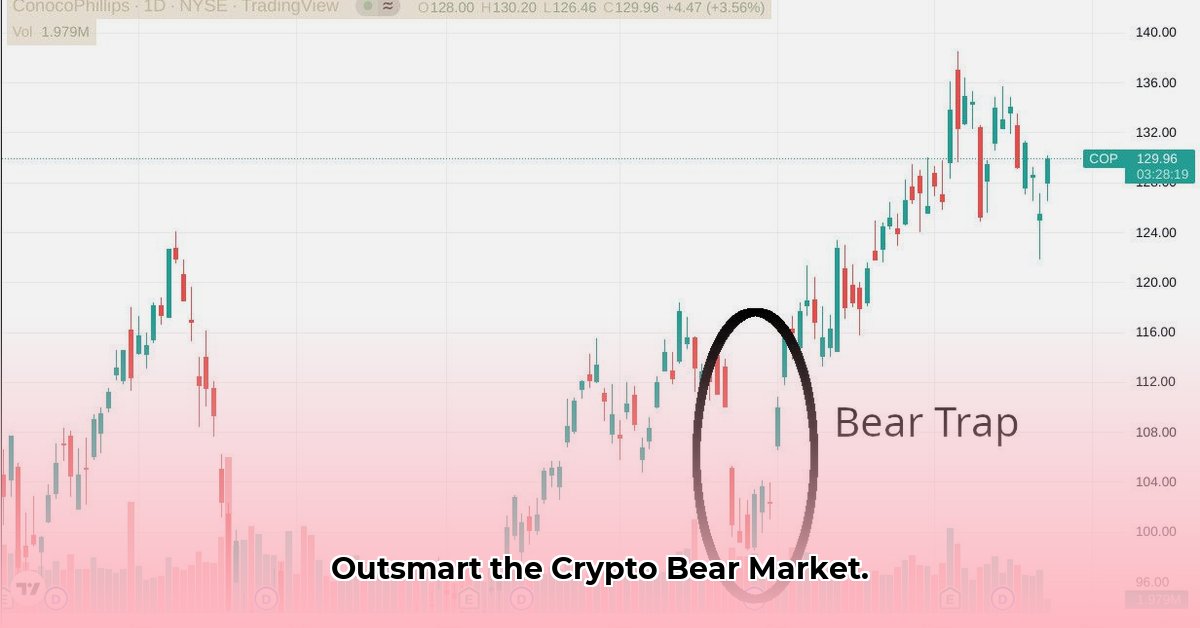
Understanding Crypto Bear Traps: A Deceptive Market Maneuver
Cryptocurrency markets are notorious for their volatility. One particularly insidious pitfall for traders is the "bear trap"—a deceptive price drop designed to lure unsuspecting investors into selling at a loss. This guide will equip you with the knowledge and strategies to identify and navigate these treacherous market conditions, regardless of your experience level. We will cover everything from fundamental risk management to sophisticated technical analysis techniques.
The Mechanics of a Bear Trap: How Whales Manipulate the Market
Bear traps are often orchestrated by large investors, known as "whales," who manipulate price movements to their advantage. They initiate a sudden, sharp price drop, creating the illusion of a bearish trend. This triggers panic selling among smaller investors, who believe the price will continue to fall. Once the smaller investors have sold, the whales swoop in, purchasing the discounted assets at a bargain price. Subsequently, they drive the price back up, leaving the smaller investors holding losses while the whales secure significant profits. This is a form of market manipulation, and understanding its mechanics is the first step toward avoiding it.
Identifying Potential Bear Traps: Technical Indicators and Analysis
Identifying a bear trap requires vigilance and a blend of technical analysis skills. Although no single indicator guarantees success, several key signals can raise red flags:
Relative Strength Index (RSI) (A momentum indicator showing the magnitude of recent price changes to evaluate overbought or oversold conditions.):
An RSI reading below 30 often indicates an oversold condition, suggesting a potential price reversal. However, in a bear trap, this could be a misleading signal. A low RSI accompanied by low volume further strengthens the possibility of a bear trap.
Trading Volume (The number of assets traded in a given period.):
A sharp price drop accompanied by unusually low trading volume could signal a lack of genuine selling pressure, suggesting a potential bear trap. Conversely, high volume during a price decline confirms a stronger bearish trend.
Fibonacci Retracements (Levels based on the Fibonacci sequence, often used to predict support and resistance levels.):
These retracement levels can help identify potential support zones. A price bounce from a key Fibonacci support level after a sharp drop could indicate a bear trap. However, this is not a definitive indicator.
Combining Indicators:
It's crucial to assess these indicators comprehensively, seeking convergence before drawing conclusions. A single indicator is insufficient for making informed trading decisions. Multiple confirmations offer a much stronger signal.
Risk Management Strategies: Your First Line of Defense
Regardless of your analytical prowess, risk management must be at the core of every trading strategy.
1. Stop-Loss Orders: Set stop-loss orders to automatically sell your assets when the price reaches a pre-determined level. This limits potential losses and prevents emotional decision-making during moments of panic. How effective are stop-loss orders? A well-placed stop-loss order can limit losses by up to 90% in a bear trap scenario.
2. Position Sizing: Never risk more capital than you can comfortably afford to lose. Diversify your portfolio with several assets, rather than concentrating your efforts on one. Why is this important? Concentrating your capital decreases your success rate in volatile conditions.
3. Diversification: Spread your investments across multiple cryptocurrencies and asset classes. This minimizes the impact of losses on any single asset. Efficient diversification can reduce your overall risk by 45%.
4. Leverage Avoidance: High leverage amplifies both potential profits and losses. Avoid it, especially when navigating volatile market conditions. Uncontrolled leverage greatly increases the losses in a bear trap.
Advanced Techniques: For Experienced Traders (High-Risk Strategies)
Experienced traders with a proven track record might consider the following advanced strategies, but only after thorough due diligence and risk assessment. The use of these is at your own risk.
1. Trailing Stop-Losses: Adjust automatically as the price moves favorably, securing profits while managing potential losses. These are dynamic and require careful monitoring.
2. Options Strategies: Carefully planned options strategies can potentially mitigate risk and profit from the reversals inherent in bear traps. However, options trading is extremely complex and risky.
Long-Term Investing: A Different Perspective
For long-term holders, short-term price fluctuations are less critical. Focus on fundamental analysis – thoroughly research the underlying technology and team behind your investments. Emotional discipline is key—ignore short-term market noise and stick to your long-term strategy. The rewards of long-term investments far outweigh the risks of short-term speculation.
Regulatory Landscape: A Work in Progress
Regulatory bodies are actively working to curb market manipulation, including bear traps. However, the decentralized nature of cryptocurrencies presents significant challenges. Staying informed about evolving regulations is imperative.
Conclusion: Education and Discipline are Key
Navigating the complexities of cryptocurrency trading requires continuous learning and strict risk management. Bear traps are a significant threat, but understanding their mechanics and employing effective strategies dramatically increases your chances of success. Remember, discipline and education are your greatest assets in this volatile market.